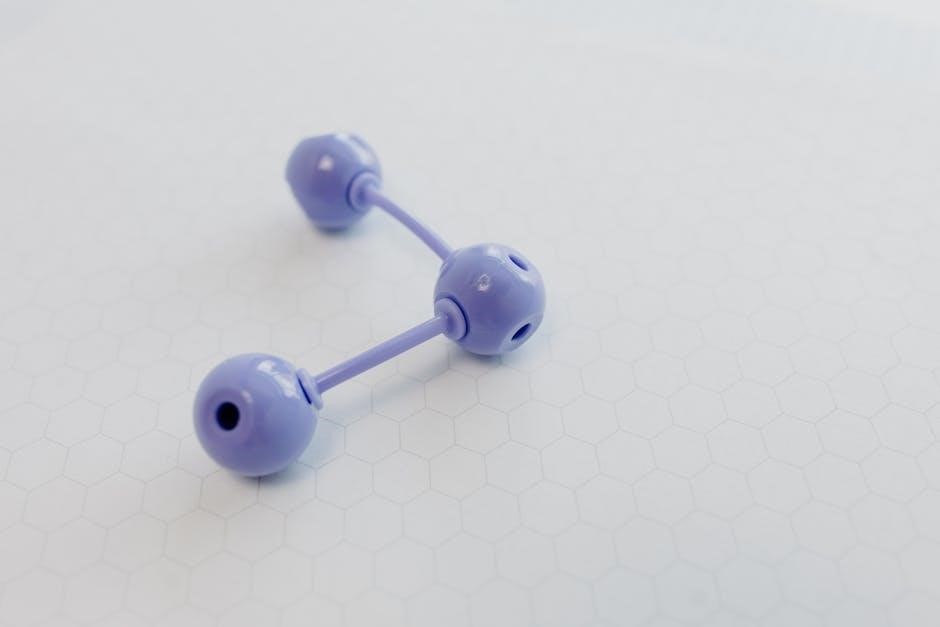
Valve guide clearance is the critical space between the valve stem and guide, essential for proper engine operation, affecting performance, longevity, and overall engine health.
1.1 What is Valve Guide Clearance?
Valve guide clearance refers to the precise space between the valve stem and its guide in an internal combustion engine. This clearance is crucial for ensuring proper valve operation, allowing the valve to move smoothly and seal effectively. The guide serves as a track for the valve stem, enabling it to open and close without obstruction. Maintaining the correct clearance is essential for engine performance, longevity, and efficiency. Proper clearance ensures optimal sealing, which prevents oil leakage and maintains compression. Incorrect clearance can lead to issues such as increased oil consumption, reduced performance, and potential engine damage. Thus, understanding and maintaining valve guide clearance is vital for overall engine health and functionality.
1.2 Importance of Proper Valve Guide Clearance
Proper valve guide clearance is essential for maintaining optimal engine performance, efficiency, and longevity. It ensures the valve stem moves smoothly within the guide, preventing excessive wear and tear. Correct clearance prevents oil leakage, maintains proper combustion chamber sealing, and reduces the risk of engine damage. Improper clearance can lead to increased oil consumption, reduced fuel efficiency, and excessive engine noise. Additionally, it can cause premature wear on valve train components, potentially leading to costly repairs. Maintaining the correct specification ensures reliable engine operation, prevents overheating, and maximizes overall engine health. Thus, proper valve guide clearance is critical for both performance and durability.

Understanding Valve Guide Clearance
Valve guide clearance is the space between the valve stem and its guide, crucial for engine efficiency and preventing wear. Proper clearance ensures smooth operation and prevents damage.
2.1 Definition and Purpose
Valve guide clearance refers to the precise spacing between the valve stem and its guide in an engine. This critical measurement ensures proper valve operation, maintaining engine performance and longevity. The guide aligns the valve, allowing smooth movement during opening and closing cycles. Proper clearance prevents excessive wear, overheating, and potential damage to valve train components. It also facilitates efficient lubrication, reducing friction and ensuring optimal combustion chamber sealing. Maintaining correct valve guide clearance is essential for reliable engine function, fuel efficiency, and overall durability. Improper clearance can lead to issues like increased oil consumption or reduced performance, emphasizing its importance in engine health.
2.2 How Valve Guide Clearance Affects Engine Performance
Valve guide clearance significantly impacts engine performance by influencing valve operation and combustion efficiency. Proper clearance ensures smooth valve movement, maintaining precise control over air-fuel mixture intake and exhaust gas expulsion. Excessive clearance can lead to mechanical noise, reduced efficiency, and increased emissions, while insufficient clearance causes overheating and wear. Both scenarios disrupt normal engine operation, potentially leading to power loss, poor fuel efficiency, and decreased reliability. Accurate clearance is vital for optimal engine function, as it directly affects combustion chamber sealing and valve train longevity. Monitoring and adjusting valve guide clearance ensures consistent performance, prevents premature wear, and maintains overall engine health.
2.3 Normal vs. Excessive Clearance
Normal valve guide clearance ensures proper valve stem movement and prevents overheating, while excessive clearance leads to mechanical noise, oil consumption, and reduced efficiency. Proper clearance allows precise valve operation, maintaining optimal engine performance and longevity. Excessive clearance disrupts valve train dynamics, causing wear on components like valve seats and guides. It also results in poor combustion sealing, increasing emissions and decreasing fuel efficiency. Insufficient clearance, however, risks valve seizure and increased friction. Striking the right balance is crucial for smooth engine operation, as deviations from manufacturer specifications can lead to premature wear or failure. Regular inspection and adjustment ensure optimal performance and prevent potential issues.

Measuring Valve Guide Clearance
Measuring valve guide clearance involves using precision tools like dial indicators and feeler gauges to ensure accuracy, adhering to manufacturer specifications for optimal engine performance.
3.1 Tools Required for Measurement
To accurately measure valve guide clearance, essential tools include a dial indicator for precise readings, feeler gauges for gap checking, and a valve spring compressor to safely access the valve train. A micrometer may also be used to measure the valve stem’s diameter, ensuring compatibility with the guide. Clean, dry rags are recommended to maintain a debris-free environment, crucial for accurate measurements. Proper tool selection and usage are vital to avoid damage and ensure reliable results.
3.2 Step-by-Step Measurement Process
Measuring valve guide clearance involves several precise steps. Begin by ensuring the engine is cool to avoid thermal expansion interference. Remove the valve cover and any additional components obstructing access to the valve train. Use a valve spring compressor to relieve tension and remove the spring, retainer, and locks. Gently pull the valve stem out of the guide. Next, attach a dial indicator to the cylinder head, positioning the tip against the valve stem. Zero the indicator and measure the lateral movement by carefully rocking the valve stem. Record the reading and compare it with the manufacturer’s specifications. Repeat for all valves to ensure consistency and accuracy.
3.3 Understanding Tolerances and Specifications
Understanding tolerances and specifications is crucial for accurate valve guide clearance measurement. Tolerances refer to the acceptable range of clearance values, typically provided by the engine manufacturer. Exceeding these limits can lead to performance issues. Specifications outline the precise measurements for valve guide clearance under various conditions. Proper interpretation ensures optimal engine operation, preventing wear and tear. Always consult the manufacturer’s guidelines for exact figures, as deviations can cause premature component failure. Adhering to these standards guarantees reliable engine performance and longevity, making it essential to follow recommended tolerances closely during measurement and adjustment processes.
3.4 Common Mistakes to Avoid During Measurement
During the measurement of valve guide clearance, several common mistakes should be avoided to ensure accuracy. Improper use of measurement tools, such as dial indicators or feeler gauges, can lead to incorrect readings. Failure to position the valve stem correctly or not accounting for thermal expansion can also result in inaccurate measurements. Additionally, neglecting to clean the valve guide before measurement can introduce errors. Always follow the manufacturer’s instructions and use calibrated tools to maintain precision. Ignoring environmental factors, such as temperature, can also affect results. By being attentive to these potential pitfalls, technicians can ensure reliable and precise measurements, which are critical for proper engine function and longevity.

Adjusting Valve Guide Clearance
Adjusting valve guide clearance involves precision techniques to ensure optimal engine performance and longevity. Proper adjustment prevents excessive wear and maintains efficient combustion chamber sealing.
4.1 When to Adjust Clearance
Adjusting valve guide clearance is necessary when symptoms like excessive oil consumption, engine noise, or decreased performance arise. These issues often indicate worn guides or improper fitment. Clearance should also be checked during engine overhauls or when replacing valves. If measurements exceed manufacturer specifications, adjustment is crucial to prevent further damage. Additionally, if the engine exhibits poor compression or increased emissions, it may signal the need for clearance correction. Regular inspections can help identify potential issues early, ensuring optimal engine function and longevity. Always consult the manufacturer’s guidelines for specific adjustment intervals and procedures to maintain proper valve guide clearance.
4.2 Methods for Adjusting Valve Guide Clearance
Adjusting valve guide clearance typically involves replacing worn guides or resizing them to restore proper fitment. Guides can be machined to exact specifications using specialized tools. In some cases, adjustable valve guides are used, allowing for precise clearance tuning. The process begins with disassembling the engine to access the valve train. Measurements are taken to determine the extent of wear. New guides are installed or existing ones are resized. Clearance is then rechecked using a dial indicator or feeler gauges. Proper torque specifications must be followed during reassembly to ensure reliability. These methods ensure optimal valve operation and prevent further engine damage, maintaining performance and efficiency.
4.3 Post-Adjustment Testing and Verification
After adjusting valve guide clearance, thorough testing is essential to ensure proper function. Conduct a compression test to verify seal integrity and check for leaks. A leak-down test can identify any remaining issues. Visually inspect the valve train for signs of wear or misalignment. Run the engine and monitor for unusual noises or vibrations, which could indicate improper clearance. Test oil consumption to ensure guides are not causing excessive leakage. Finally, confirm that engine performance, such as power and smooth operation, has improved. Proper testing ensures reliability and prevents future issues, validating the adjustment process and maintaining engine efficiency.

Symptoms of Incorrect Valve Guide Clearance
Incorrect valve guide clearance leads to poor engine performance, increased oil consumption, excessive noise, and reduced fuel efficiency, signaling potential issues requiring immediate attention.
5.1 Effects on Engine Performance
Incorrect valve guide clearance significantly impacts engine performance by affecting combustion efficiency and mechanical operation. Excessive clearance can lead to improper valve sealing, resulting in reduced compression and power loss. Insufficient clearance may cause valves to stick, disrupting normal combustion cycles. Both scenarios can cause engine misfires, rough idling, and a noticeable decrease in overall performance. Additionally, improper clearance can lead to uneven fuel combustion, further reducing efficiency. Over time, these issues can escalate, causing more severe damage to engine components. Addressing valve guide clearance is crucial to maintaining optimal engine function and preventing long-term mechanical failures.
5.2 Increased Oil Consumption
Excessive valve guide clearance often leads to increased oil consumption, as engine oil can seep into the combustion chamber through the gap between the valve stem and guide. This occurs when the valve guide wears out, allowing oil to bypass the seal. Over time, this results in blue smoke emanating from the exhaust and a noticeable decrease in oil levels. Regular oil top-ups become necessary, and if left unaddressed, it can lead to premature wear on engine components. Increased oil consumption is a common symptom of worn valve guides, highlighting the importance of monitoring and maintaining proper clearance to prevent unnecessary costs and potential engine damage.
5.3 Excessive Noise from the Engine
Excessive valve guide clearance can lead to noticeable engine noise, typically a tapping or knocking sound. This occurs when the valve stem moves excessively within the worn guide, creating mechanical noise during engine operation. The sound is often more pronounced when the engine is cold or under load. Over time, this noise can escalate as the wear progresses, indicating potential damage to the valve train components. Addressing excessive clearance early is crucial to prevent further deterioration and costly repairs. This symptom serves as a clear warning sign for mechanics to investigate and correct the valve guide clearance issue promptly. Regular maintenance can help identify such problems before they become severe.
5.4 Decreased Fuel Efficiency
Decreased fuel efficiency is a common consequence of improper valve guide clearance. Excessive clearance allows the valve to move inefficiently, disrupting the combustion process and reducing engine performance. This leads to incomplete fuel burning, which directly impacts mileage and overall fuel economy. Additionally, the engine may experience rough idling or misfires, further decreasing efficiency. As the valve train components wear, the engine compensates by consuming more fuel to maintain power output. Over time, this can result in higher fuel costs and increased emissions. Addressing valve guide clearance issues promptly is essential to restore optimal engine performance and fuel efficiency, ensuring the vehicle operates as intended. Regular inspections and maintenance are key to preventing such inefficiencies.

Consequences of Excessive Valve Guide Clearance
Excessive valve guide clearance can lead to increased wear on valve train components, reduced engine efficiency, and potentially result in premature engine failure over time.
6.1 Increased Wear and Tear on Valve Train Components
Excessive valve guide clearance leads to increased wear and tear on valve train components due to improper alignment and movement of the valve stem within the guide. This misalignment causes abnormal friction, accelerating the deterioration of both the valve stem and guide. Over time, this wear can lead to premature component failure, as the valve train is subjected to additional stress and heat generation. The increased movement also disrupts the precise operation of the valve, potentially causing further damage to adjacent engine parts. If left unaddressed, this wear can significantly reduce engine performance and longevity, ultimately requiring costly repairs to restore proper functionality.
6.2 Reduced Engine Efficiency
Excessive valve guide clearance can significantly reduce engine efficiency by disrupting the precise operation of the valve train. The increased movement of the valve stem within the guide leads to improper valve seating, causing compression leaks and reducing the engine’s ability to generate power effectively. This inefficiency results in decreased performance, as the engine struggles to maintain optimal combustion pressure. Additionally, the engine may consume more fuel to compensate for the loss of efficiency, leading to lower fuel economy. Over time, this issue can also increase emissions, as incomplete combustion contributes to higher levels of harmful pollutants. Reduced engine efficiency ultimately impacts overall vehicle performance and reliability.
6.3 Potential for Premature Engine Failure
Excessive valve guide clearance increases the risk of premature engine failure by causing improper valve operation and increased stress on critical components. The valve train components, such as lifters and camshafts, endure additional wear due to the unstable movement of the valve stem. Over time, this can lead to catastrophic damage, including cracked or bent valves, and compromised piston rings. The engine’s ability to maintain proper compression and oil circulation is also impaired, accelerating wear on cylinder walls and head components. If left unaddressed, these issues can culminate in costly repairs or even complete engine failure, emphasizing the importance of maintaining proper valve guide clearance to ensure long-term engine longevity and performance.

Consequences of Insufficient Valve Guide Clearance
Insufficient valve guide clearance causes increased friction, heat generation, and risk of valve seizure, potentially leading to cylinder head damage and costly repairs.
7.1 Risk of Valve Seizure
Insufficient valve guide clearance increases friction between the valve stem and guide, leading to excessive heat generation. Over time, this can cause the valve to seize within the guide, halting proper movement. A seized valve disrupts engine operation, potentially causing cylinder head damage and requiring costly repairs. Proper lubrication and maintenance are critical to prevent this issue. Regular inspections ensure clearance remains within manufacturer specifications, reducing the risk of seizure and associated engine damage. Addressing insufficient clearance early is vital to avoid severe consequences and maintain optimal engine performance. Neglecting this can lead to premature wear of valve train components and compromised engine efficiency.
7.2 Increased Friction and Heat Generation
Insufficient valve guide clearance results in increased friction between the valve stem and guide, leading to excessive heat buildup. This friction generates high temperatures, which can damage valve train components and degrade engine performance. Prolonged exposure to heat causes wear on the valve stem and guide, accelerating component failure. Additionally, increased friction reduces engine efficiency and fuel economy. Proper clearance ensures smooth operation, minimizing heat generation and maintaining optimal engine function. Regular inspections and adjustments are essential to prevent these issues, as excessive heat can lead to premature component failure and costly repairs. Maintaining correct clearance is crucial for sustaining engine health and performance.
7.3 Potential Damage to Cylinder Head
Insufficient valve guide clearance can lead to potential damage to the cylinder head. Tight clearance causes increased friction, generating excessive heat that can transfer to the cylinder head. Over time, this heat and stress may cause warping or cracking of the head. Additionally, improper valve seating due to insufficient clearance can allow combustion gases to escape, further damaging the cylinder head. This can result in costly repairs, including resurfacing or replacing the head. Maintaining proper clearance is critical to prevent these issues and ensure long-term engine reliability. Neglecting this can lead to severe damage, requiring extensive and expensive cylinder head repairs or replacement. Regular inspections are essential to avoid such complications.

Diagnosis of Valve Guide Clearance Issues
Diagnosing valve guide clearance issues involves visual inspection, compression testing, and measuring tools like dial indicators to assess wear and deviation from specifications.
8.1 Visual Inspection of Valve Guides
A visual inspection of valve guides is a crucial diagnostic step to identify wear or damage. Technicians examine the valve guides for signs of excessive clearance, such as scoring, wear patterns, or discoloration. The valve stem and guide interface should be inspected for abnormal movement or gaps, which can indicate worn components. Using a flashlight and magnifying glass can help spot imperfections. Additionally, checking for oil residue or leakage around the guides can reveal excessive clearance, as valves may not seal properly. Visual inspection provides initial clues about potential issues, guiding further testing or measurement. It is a non-invasive method to assess guide condition before proceeding with precise measurements or repairs.
8.2 Compression Testing
Compression testing is a diagnostic method used to assess the integrity of engine cylinders and valve train components. By measuring the compression pressure within each cylinder, technicians can identify issues related to valve guide clearance. Low compression may indicate excessive clearance, allowing engine pressure to escape. The test involves inserting a compression gauge into the spark plug port and cranking the engine to record pressure readings. Comparing results across cylinders helps pinpoint problematic areas. While compression testing doesn’t directly measure valve guide clearance, it provides indirect evidence of potential issues, guiding further inspection or measurement. This method is essential for diagnosing internal engine health and identifying the need for more detailed valve guide analysis.

Repairing Valve Guide Clearance Issues
Repairing valve guide clearance issues typically involves replacing worn guides or machining them to restore proper specifications and ensure optimal engine performance.
9.1 Replacing Worn Valve Guides
Replacing worn valve guides is a common repair to restore proper clearance and functionality. The process involves removing the valve and guide, then installing a new guide using specialized tools. Measurements are critical to ensure the replacement guide meets factory specifications. Proper alignment and seating are essential to prevent future issues. Once installed, the valve is reassembled, and clearance is rechecked. This repair is often performed during engine overhauls or when excessive wear is detected. It requires precision to avoid further damage to the valve train components. Correct installation ensures smooth engine operation, reduces oil consumption, and minimizes noise. Regular inspections can prevent the need for such repairs by addressing wear early.
9.2 Machining or Resizing Valve Guides
Machining or resizing valve guides is an alternative to replacement, often used when guides are slightly worn. This process involves using specialized tools to reshape the guide to restore proper clearance. The valve guide is carefully measured to ensure accurate resizing. Precision is critical to avoid damaging the cylinder head or surrounding components. Once resized, the valve is reinstalled, and clearance is verified. This method is cost-effective for minor wear but may not be suitable for severely damaged guides. Proper technique and tools are essential to achieve a precise fit and prevent future issues. Resizing can extend the life of the valve train and maintain optimal engine performance.

Maintenance Tips for Valve Guide Clearance
Regular inspection and lubrication are crucial for maintaining proper valve guide clearance. Ensure guides are clean and free from debris to prevent wear and ensure smooth operation.
10.1 Regular Inspection Schedule
A well-planned maintenance schedule is essential for maintaining optimal valve guide clearance. Inspections should be performed every 30,000 to 50,000 miles or as recommended by the manufacturer. During these checks, visually examine the valve guides for signs of wear, dirt, or damage. Use specialized tools to measure clearance and ensure it aligns with manufacturer specifications. Clean the guides thoroughly to remove any debris or carbon buildup, which can affect performance. Addressing issues early prevents excessive wear and potential engine damage. Regular lubrication of the valve train components is also critical to reduce friction and heat generation. A consistent inspection routine helps maintain engine efficiency and longevity.
10.2 Lubrication Best Practices
Proper lubrication is vital for maintaining optimal valve guide clearance and overall engine health. Use high-quality motor oil with the correct viscosity recommended by the manufacturer to reduce friction and wear. Regularly lubricate the valve train components, including the guides and stems, to prevent excessive heat buildup. Apply a small amount of Marvel Mystery Oil or similar products to the valve guides during maintenance for added protection and cleaning. Avoid over-lubrication, as it can attract dirt and debris, leading to premature wear. Ensure lubrication intervals align with the manufacturer’s schedule, typically every 5,000 to 7,500 miles. Proper lubrication enhances engine performance, reduces wear, and extends the lifespan of valve train components.
Proper valve guide clearance is crucial for engine performance, longevity, and efficiency. Regular maintenance, correct adjustments, and timely repairs ensure optimal functionality and prevent premature wear.
11.1 Summary of Key Points
Proper valve guide clearance is essential for engine performance, longevity, and efficiency. It ensures smooth operation of valve train components, prevents excessive wear, and maintains optimal engine health. Incorrect clearance, whether too tight or too loose, can lead to issues like increased oil consumption, noise, and reduced fuel efficiency. Regular inspection, accurate measurement, and timely adjustments are critical to avoiding these problems. Understanding symptoms, such as excessive noise or decreased performance, helps in early diagnosis. Maintenance practices, including lubrication and inspections, play a vital role in preserving valve guide integrity. Addressing clearance issues promptly, through repairs or replacements, prevents severe engine damage and ensures reliable operation.
11.2 Final Thoughts on Maintaining Proper Valve Guide Clearance
Maintaining proper valve guide clearance is crucial for ensuring the longevity and efficiency of an engine. Regular inspections and timely adjustments prevent wear and tear, while addressing issues early avoids costly repairs. Proper clearance ensures smooth valve operation, reduces oil consumption, and minimizes noise. It also enhances fuel efficiency and overall engine performance. Neglecting valve guide clearance can lead to severe damage, including valve seizure or premature engine failure. By following best practices for measurement, adjustment, and maintenance, engine longevity and reliability can be maximized. Always refer to manufacturer specifications and consider professional assistance for complex repairs to ensure optimal results.
 betta fish care guide pdf
betta fish care guide pdf  dsc impassa user guide
dsc impassa user guide  local tv guide pittsburgh pa
local tv guide pittsburgh pa  atc guide mode
atc guide mode  ap world exam study guide
ap world exam study guide  tsi math study guide pdf
tsi math study guide pdf  iproven thermometer manual
iproven thermometer manual  ninja foodi air fryer instruction manual
ninja foodi air fryer instruction manual  48 laws of power summary pdf
48 laws of power summary pdf